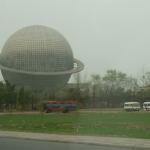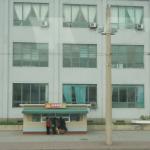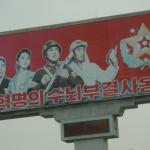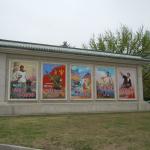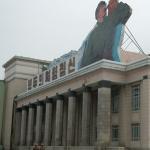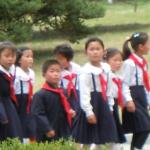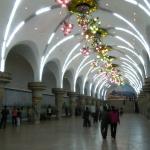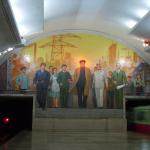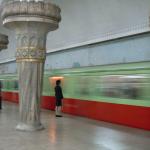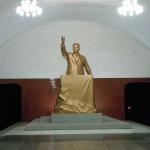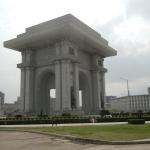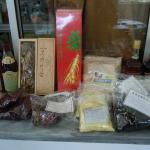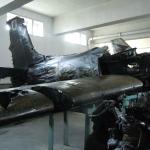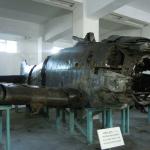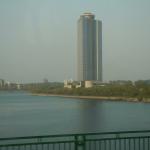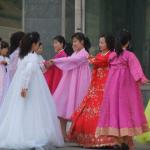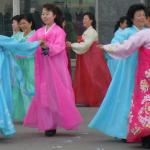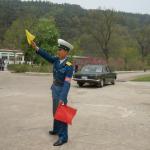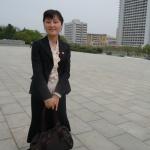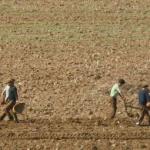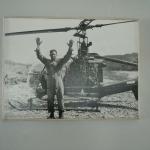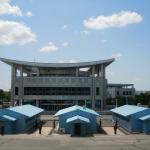© 2011 Sabrina Swenson. All Rights Reserved.
North Korea
May, 2012
As I filled out the application, I agreed to the trip on their terms. Photography only permitted when announced it was ok; check. No bad mouthing the current or former leaders or regime; check. Flowers must be presented and bowing must occur when visiting the bronze statues of the two former leaders; check, check. An all around basically do as you're told without question; check. And so, upon agreeing to the terms set before us, twelve people stepped onto an Air Koryo flight bound for the hermit kingdom, North Korea.
As you can imagine North Korea is not a common destination. As such, special planning is required when traveling there. It actually wasn't until just a few years ago that Americans and South Koreans were even allowed into the country. My usual solo, independent travel is simply not allowed in North Korea so you are required to go through an agency. I did research and found an excellent company in Beijing, China that specialized in North Korea travel. This company secured my visa and finalized all the plans in advance for the trip. Once in Beijing I reported for the briefing to meet the other people on the tour and hear of the dos and don'ts of North Korea travel. It included such information as our hotel room would most likely be bugged and that postcards could be sent but would most certainly be read first and so any writing should be kept nice. Mostly we were told again and again not to disrespect the current or former leaders or regime in any way, not to challenge the North's version of the Korean war and to never wander off alone without our guides. A trip to North Korea is completely on the government's terms. Two government-appointed local guides accompany every tourists group. If one cannot accept these rules, one should not travel to North Korea.
I originally wanted to travel to North Korea, ironically official named the Democratic People's Republic of Korea or the DPRK, because I wanted to see if it was as sterile as it appeared in the news. After my time in North Korea I can confirm yes, it really is as it appears on TV and in the news. I call Pyongyang vast and vacant. Huge buildings and avenues but with no one around. The place looks and feels empty on most days. There is no Internet in North Korea and the small percentage of people that have cell phones, cannot call outside of the country. They are, in essence, completely cut off from the rest of the world.
I was surprised to find such a nice, new aircraft when boarding the Air Koryo flight in Beijing. The flight attendants were in bright red suits and the first thing that caught my eye was the lapel pin each crew member had on of the great leader. I would come to find that all North Koreans in Pyongyang wear a lapel pin of the "great leader" Kim Il-Sung every day. If a person has special importance or has done something of special significance, like being in the military, they then have a pin with pictures of the faces of not only the great leader but also of his son the recently departed Kim Jong-Il known as the dear leader.
Upon arrival into Pyongyang we walked into the tiny terminal and went through customs. Foreign cell phones are not allowed in North Korea and anyone who brings in a cell must check it at the airport. We met our guides and boarded a bus into the city. The two local government appointed guides; Mr. Kim and Miss Kim (no relation) were kind, patient and warm people. Since photography is strictly controlled in North Korea they informed us when we could and could not take photographs throughout the trip. We rode into the city and the first thing I noticed was all the propaganda posters and billboards that could be found throughout the city. Many depicted angry looking people, fists in the air with weapons and or missiles. There were also huge billboards with pictures of the great leader and the dear leader on them. What struck me most about these pictures was that every picture of these men had them smiling from ear to ear with a megawatt smile.
On the drive through Pyongyang we stopped at their Arch de Triumph. They proudly claim it is larger than the one in Paris. At 197 feet high and 164 feet wide it really is massive and quite beautiful. The site in which it is built is where Kim Il-Sung first addressed the liberated Koreans after the end of Japanese occupation in 1945. We continued to our hotel which, strangely, was on an island in the middle of the Taedong River which cuts through the middle of Pyongyang. It looked funny to see this huge tourist hotel on an island in the middle of Pyongyang. The river actually looked more like a moat surrounding the hotel, I thought. Although the hotel was pretty basic, from my high floor I had a great view of Pyongyang. I thought it strange the next morning when gazing out the window at a time when you would usually find rush hour traffic in a city of three million people, instead, I only saw one lone car on the road.
The hotel had many activities like saunas, restaurants, bowling, karaoke, disco, shops and a casino. This, of course, is all designed because they do not want you leaving the hotel without your guides. Our days were packed, however and quite frankly there was little time for hanging out at any of the hotels facilities. Breakfast would be early in the morning before we would pile on the bus and be off for an all day trip seeing many sights. Our first stop was a walk along the Taedong River where we ended up at Kim Il-Sung Square. This was most impressive to me. It's the central square and marching ground that can be seen in the news whenever there is a military parade. The square is eerily vacant. There are massive buildings in the square but no one around except for maybe a few random people here and there. I also discovered the secret of the perfect lines that the people are in whenever there is a military parade. Every few inches of the entire Kim-Il Sung square there is a white dot spray painted perfectly in line to denote where a person should stand during a parade, thereby making perfect lines. The most impressive building in the square is the Grand People's Study House. This gigantic library is the most beautiful building in Pyongyang and houses over 30 million books.
One day we went North of the city for an hour and a half to do some hiking in the woods. We also stopped at the International Friendship Exhibition hall or as I like to call it, the gift museum. It is built into the side of a mountain. It is said to contain 220,000 items given to the great leader and dear leader as gifts from around the world. Before entering we were required to remove our shoes and put on booties so as not to scratch the marble floor. We walked through metal detectors before being whisked into the first room. Room after room we were shown and it appears that the DPRK has received an unbelievable amount of "goods" from other nations throughout the years. It included the oddest assortment of gifts imaginable. Some items included a bullet-proof limousine from Josef Stalin, a very modern desk and chair from France and a giant teddy bear from the former East Germany. In 2000, former U.S. Secretary of State Madeleine Albright brought a basketball signed by Michael Jordan there was also a bird statue from the Reverend Billy Graham. Other odd items included an entire train carriage, a bear's head, vases and weapons. The oddest and most amusing I found was a gift from Nicaragua; a grinning stuffed alligator, mounted upright and offering drinks from a wooden cocktail tray carried in its claws. The gifts were housed in gigantic rooms and one room opened up to another. It made me wonder what other nations did with their gifts. You don't hear about a lot of "gift museums" in the world.
Another day we were taken down to the Pyongyang subway system, the metro. One of the deepest metros in the world it doubles as a nuclear bunker with blast doors that close should an attack happen on Pyongyang. It is also one of the most elaborately decorated metros with chandeliers and murals of the great leader and his followers painted on some of the walls. We rode a few stops and as we packed into the full train car my arm was yanked by a local and I was ushered to a seat that had been vacated for me. As my fellow travelers were amused by the spectacle I was bombarded with questions such as where did I live, where was I going, what did I think of Pyongyang and so forth. The man appeared to enjoy practicing his English and even translated questions from the elderly man sitting next to me.
Another day we stopped at the Victorious Fatherland Liberation War Museum which houses much military hardware such as war-damaged aircraft and tanks. The North Koreans saved them from the war, placed them in the basement and the museum was built around them. After we heard our guides' version of the Korean war when asked if we had any questions, everyone remained silent. Their version is obviously quite a bit different from everyone else's in the world but arguing with them would get us nowhere. Besides, offending a host country is never a good thing, especially when your host is North Korea, and so we asked no questions.
We also stopped one day at a sight I had never even heard about until my research of North Korea. The USS Pueblo is the only US Navy ship being held captive today. In 1968 the US ship was sailing in International waters near North Korea when the DPRK claimed it had sailed into its waters. The North Koreans boarded the vessel killing one soldier in the process and captured and held prisoner the remaining crew of 82 men. The crew were held for 11 months and were only released after the US formerly wrote a letter admitting fault for the incident. Once the entire crew was released the US immediately retracted the letter restating they had been in International waters. The USS Pueblo is still in North Korea today docked in Pyongyang where it is used as a museum ship. While inside the Pueblo we were shown a film depicting the North Korean take on the events. When the film was over the guide of the Pueblo asked if we had any questions. The other American on the tour and I just looked at each other and shook our heads. Again, we knew any questioning or actual facts of the incident would not go over well with our hosts and so we just smiled.
While in Pyongyang we also did something I would have never guessed possible in North Korea, we went bowling! Yes, Pyongyang has a bowling alley as good as anywhere else. Although my bowling abilities hadn't been tested since 1986 high school gym class, I enjoyed the camaraderie of bowling with our North Korean guides who were actually both very good. As I've found in most countries that are considered to be "axis of evil", although the leadership of the country maybe seriously questionable, the average everyday person is very pleasant.
One of the most interesting stops on the trip was a drive down to the Demilitarized Zone (DMZ) to see firsthand the stand off where South Korean and American soldiers watch their Northern counterparts and vice versa as they have done every day since 1953. It is a sad sight of a pointlessly divided nation. The DMZ is approximately 160 miles long and 2.5 miles wide and is the most heavily militarized border in the world. The drive from Pyongyang was down a strangely empty 6 lane highway. I was told people simply don't have money for fuel and this is the reason the roads are always so empty. As we drove I noticed the poor soil of the countryside further worsened by recent droughts. With an absence of farming equipment, I saw people on their hands and knees planting fields by hand. The soil seemed very dry and not of very good quality, that is, until the last couple miles before reaching the DMZ. There the land was lush and green, watered and well taken care of. I can only assume this was for the show of the South Koreans who, upon looking across the DMZ would see nothing but supposed beautiful countryside in the North.
Upon arriving in the area we were required to exit the bus and go into a military post where a soldier showed us a model of the entire site showing us the North and South's Headquarters and watchtowers. We were then required to walk single file through an anti-tank barrier to reboard our bus. We were strictly told no photographs should be taken along this road. We eventually arrived at the demarcation line and were quickly moved along. There you find the headquarters of each side facing one another on opposite sides of the DMZ. Numerous cameras are positioned on each building photographing the other side. There are also three blue huts built right on the line for meetings. We were quickly ushered into one of the blue huts, given a brief account of the area and quickly ushered out. The two North Korean guards stood at the ready inside the hut with weapons in hand, eyes straight forward and a seriousness on their faces. I would have liked to have stayed longer but we were ushered out pronto. In North Korea, you don't really have a say.
One of the oddest places we were taken to on our journey in North Korea was to the Mansudae Grand Monument in Pyongyang. Here gigantic bronze statues of the two former leaders stand towering over all who visit. North Koreans take these statues very seriously and the utmost respect to the statues and area in general is expected. There were hundreds of North Koreans visiting the day we were there, as I was told there are most days. When it was our turn to proceed to the statutes, we walked up as a group, presented a few bouquets of flowers walked back a few steps and then bowed in unison. It's not every day you get to do this kind of pomp and circumstance.
We were in Pyongyang during the May day holiday or worker's day as it is also known. It's a big celebration in North Korea. We went to the park where we found I think all of Pyongyang's three million residence celebrating. They were grilling food, chatting and playing games. We were shocked when our guides told us we could roam free and to just be back in an hour. We looked at each other briefly before running off in all different directions. We couldn't believe we were allowed to run free in essence, if even only for an hour. Although after looking around the park, it is obvious most of Pyongyang's residents are in the military. Military uniforms could be found everywhere so I guess we weren't really free or alone. I went with a couple other people to wander around the area and we watched some of the games being played including a big tug of war that was going on. The worst game, I thought, had a group of small children lined up. I saw the first little kid handed a big long stick. The child ran down the grass to a life-sized, stuffed, human shaped dummy where the kid beat the dummy trying to knock it off its stick. If he or she succeeded the crowd cheered. The kid then ran back up the grass to the next kid handing off the big stick where the process was repeated. The dummy was propped up again and the next kid tried to beat it down. The worse part was when every kid had their chance the dummy was left on the ground and all the kids ran to it and started to stomp on it and yell. I'm no parent but I'm guessing this is a highly inappropriate game for a small child, or any child!
A more beautiful sight on May day was the mass dance as they are called. Hundreds of North Korean women in the traditional dress could be found dancing in a mass dance in the city. Every dress was a different color; it was beautiful to watch.
I actually enjoyed my time in North Korea even though I must say it's the oddest place I've ever been. I have no doubt that our tour was a carefully orchestrated itinerary approved by the government in advance showing us only what they wanted us to see. It would have been interesting to just jump in a car and drive wherever I wanted but, of course, that was simply not possible. Maybe someday these two countries will once again be one. After what I saw, sadly, I don't think that day will be coming anytime soon.



